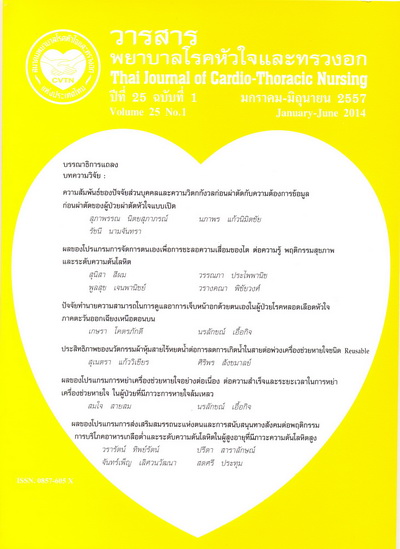ผลของโปรแกรมการหย่าเครื่องช่วยหายใจอย่างต่อเนื่องต่อความสำเร็จและระยะเวลาในการหย่าเครื่องช่วยหายใจ ในผู้ป่วย ที่มีภาวะการหายใจล้มเหลว
คำสำคัญ:
โปรแกรมการหย่าเครื่องช่วยหายใจ, ความสำเร็จของการหย่าเครื่องช่วยหายใจ, ภาวะการหายใจล้มเหลว, Weaning ventilator protocol, success rate of weaning from mechanical ventilator, respiratory failureบทคัดย่อ
การวิจัยครั้งนี้เป็นการวิจัยกึ่งทดลอง เพื่อศึกษาผลของโปรแกรมการหย่าเครื่องช่วยหายใจอย่างต่อเนื่องต่อความสำเร็จและระยะเวลาในการหย่าเครื่องช่วยหายใจ ในผู้ป่วยที่มีภาวะการหายใจล้มเหลว กลุ่มตัวอย่าง 54 คน คือ ผู้ป่วยอายุรกรรมวัยผู้ใหญ่ ที่ได้รับการวินิจฉัยว่ามีภาวะการหายใจล้มเหลวที่ได้รับการใส่ท่อช่วยหายใจ และใช้เครื่องช่วยหายใจ ในหอผู้ป่วยหนัก และหอผู้ป่วยอายุรกรรม โรงพยาบาลโพธาราม จังหวัดราชบุรี แบ่งเป็นกลุ่มควบคุม และกลุ่มทดลอง กลุ่มละ 27 คน โดยกลุ่มควบคุมได้รับการหย่าเครื่องช่วยหายใจตามวิธีปกติตามประสบการณ์และความรู้ของแพทย์และพยาบาล กลุ่มทดลองได้รับการหย่าเครื่องช่วยหายใจ ตามโปรแกรมการหย่าเครื่องช่วยหายใจอย่างต่อเนื่อง ที่ผู้วิจัยพัฒนาตามแนวคิดกระบวนการหย่าเครื่องช่วยหายใจของสมาคมพยาบาลภาวะวิกฤตสหรัฐอเมริกา (1998) แบ่งเป็น 3 ระยะ 1)ระยะก่อนหย่าเครื่องช่วยหายใจ 2)ระยะหย่าเครื่องช่วยหายใจ และ 3) ระยะประเมินผลการหย่าเครื่องช่วยหายใจ ซึ่งประเมินผลโดยวัดอัตราความสำเร็จ และระยะเวลาในการหย่าเครื่องช่วยหายใจ วิเคราะห์ข้อมูล โดยใช้สถิติเชิงพรรณนา Independent Z-test และ ค่า Independent t-test
ผลการวิจัยสรุปดังนี้ 1)ผู้ป่วยที่มีภาวะการหายใจล้มเหลวที่ได้รับโปรแกรมการหย่าเครื่องช่วยหายใจอย่างต่อเนื่อง มีอัตราความสำเร็จในการหย่าเครื่องช่วยหายใจสูงกว่ากลุ่มควบคุมที่ได้รับการหย่าเครื่องช่วยหายใจตามวิธีปกติ อย่างมีนัยสำคัญทางสถิติที่ระดับ .05 และ 2)ผู้ป่วยที่มีภาวะการหายใจล้มเหลวที่ได้รับโปรแกรมการหย่าเครื่องช่วยหายใจอย่างต่อเนื่อง มีระยะเวลาในการหย่าเครื่องช่วยหายใจน้อยกว่ากลุ่มควบคุมที่ได้รับการหย่า เครื่องช่วยหายใจตามวิธีปกติ อย่างมีนัยสำคัญทางสถิติที่ระดับ .05
ผลการศึกษานี้สามารถนำไปพัฒนาแนวปฏิบัติการหย่าเครื่องช่วยหายใจอย่างต่อเนื่องให้มีความเหมาะสมกับบริบทและสถานที่ เพื่อช่วยพัฒนาคุณภาพการพยาบาลผู้ป่วยที่หย่าเครื่องช่วยหายใจให้มีประสิทธิภาพยิ่งขึ้น
Effects of Weaning Continuum Program on Success and Duration of Ventilator Weaning amoPatients with Respiratory Failure
The purpose of this quasi-experimental research was to examine the effects of weaning continuum program onsuccess rate and duration of ventilator weaning among patients with respiratory failure. Fifty-four critically ill adults patients diagnosed with respiratory failure and on ventilator via intubation were recruited from the medical intensive care unit and the medical ward at Photharam Hospital, Rajburi. Twenty-seven patients were randomly assigned to the control group and twenty-seven were assigned to the experimental group. The control group received the method of the weaning ventilation based on professional standards and experiences. The experimental group received the weaning continuum program developed by researchers based on the concept of the weaning program of American Association of Critical-Care Nursing in 1998. This program was composed of 1)pre-weaning phase; 2)weaning phase; and 3)the phase of weaning outcome evaluation measured by the success rate and duration of weaning. Data were analyzed using descriptive statistic, Independent Z-test, and Independent t-test.
The research findings showed: 1)the experimental group after receiving the program was significantly higher success rate than the control group at the significant level of .05. 2)the experimental group after receiving the program had shorter duration of weaning success than the control group at the significant level of .05
The finding could help nurses to develop the guideline of weaning ventilators continuously which is proper with nursing contexts and health setting. This would help nurse to improve nursing quality of weaning from ventilator efficiently.
ดาวน์โหลด
เผยแพร่แล้ว
รูปแบบการอ้างอิง
ฉบับ
ประเภทบทความ
สัญญาอนุญาต
บทความนี้ยังไม่เคยตีพิมพ์หรืออยู่ในระหว่างส่งไปตีพิมพ์ในวารสารอื่น ๆ มาก่อน และกองบรรณาธิการขอสงวนสิทธิ์ในการตรวจทาน และแก้ไขต้นฉบับตามเกณฑ์ของวารสาร ในกรณีที่เรื่องของท่านได้ได้รับการตีพิมพ์ในวารสารฉบับนี้ถือว่าเป็น ลิขสิทธิ์ของวารสารพยาบาลโรคหัวใจและทรวงอก






